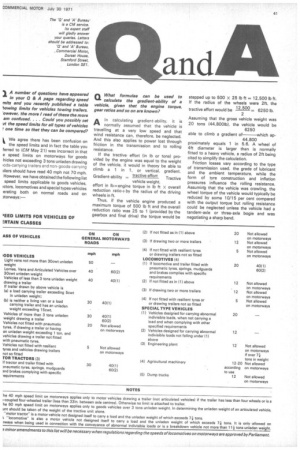a What formulae can be used to calculate the gradient-ability of
Page 43

If you've noticed an error in this article please click here to report it so we can fix it.
a vehicle, given that the engine torque, gear ratios and so on are known?
AIn calculating gradient-ability, it is normally assumed that the vehicle is travelling at a very low speed and that wind resistance can, therefore, be neglected. And this also applies to power lost through friction in the transmission and to rolling resistance.
If the tractive effort (in lb or tons) provided by the engine was equal to the weight of the vehicle, it would in theory be able to climb a 1 in 1. or vertical, gradient.
Gradient-ability
tractive effort
Tractive
vehicle weight. effort in lb=engine torque in lb ft X overall reduction ratio+ by the radius of the driving wheels in ft.
Thus, if the vehicle engine produced a maximum torque of 500 lb ft and the overall reduction ratio was 25 to 1 (provided by the gearbox and final drive) the torque would be stepped up to 500 X 25 lb ft 12,500 lb ft.
If the radius of the wheels were 2ft, the
tractive effort would be 12'500 6250 lb.
Assuming that the gross vehicle weight was 20 tons (44,800Ib), the vehicle would be 6250
able to climb a gradient of which ap44.800
proximately equals 1 in 5.6. A wheel of 4ft diameter is larger than is normally fitted to a heavy vehicle, a radius of 2ft being cited to simplify the calculation.
Friction losses vary according to the type of transmission used, the grade of lubricant and the ambient temperature, while the form of tyre construction and inflation pressures influence the rolling resistance. Assuminb that the vehicle was crawling, the wheel torque of the vehicle would typically be reduced by some 10/15 per cent compared with the output torque but rolling resistance could be neglected unless the vehicle had a tandem-axle or three-axle bogie and was negotiating a sharp bend.




















































































